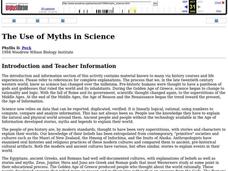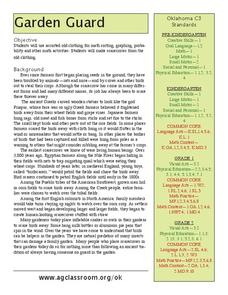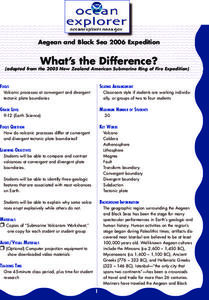NOAA
I Can't Breathe!
The Gulf of Mexico dead zone, an area of low oxygen that kills marine life, costs the United States $82 million every year. Young scientists research anoxic ocean environments then come up with a hypothesis for the cause of the Gulf of...
New South Wales Department of Education
History of Plant Classification
Bamboo, the fastest growing plant in the world, can grow up to 35 inches in one day! Pupils learn how plants historically have been classified and determine if these traits are appropriate to use in this 17th lesson of 20. They will also...
Activated Story Theatre
Orpheus- A Greek Myth: Reader's Theatre Script
Is this any way to treat a Greek Myth? By all means, turn the tale of Orpheus into a reader's theatre exercise.
It's About Time
Sounds in Strings
How many of your pupils play an instrument? A musical science lesson will help all of them understand how string instruments work. Young scientists construct a string-and-pulley system to test frequency and pitch. The lesson...
Curated OER
Stolen Property or Finders Keepers
Learners explore the questionable acquisition of priceless artworks gained as spoils of World War II. They become investigators and reporters looking into the matter of ownership of the world's greatest art.
Curated OER
Mosaics
Studnets study mosaics, including the historical background of the art form. They study the cultures that have used mosaics in their art work, and then they construct their own mosaics.
Curated OER
The Use of Myths in Science
Students are told stories, myths and legend to explain their world. After telling the tales and discussion them, students are assigned to write a myth that describes a familiar situation, such as why the school garbage cans are always...
Curated OER
The Use of Myths in Science
Young scholars examine folk tales to determine the basis for scientific myths. They demonstrate through the discussion of the folk tales that the perception of the world has changed as new information is gained. They write their own...
Curated OER
Cloudy Days are for Reading and Writing
Students research weather proverbs and determine the scientific validity of 3 weather proverbs. They write an essay presenting their reasoning. They interview elderly people to graph the most frequently heard proverbs and theorize...
Curated OER
"Theseus and the Minotaur"
Students analyze the features of myths and legends. They read the myths "Theseus and the Minotaur" and "Orpheus and Eurydice," identify the myth story elements, evaluate each story for the overall theme, describe the characters, and...
Curated OER
Symmetry in Paper Airplanes
Young scholars explore symmetry. In this geometry and scientific inquiry lesson, students design paper airplanes with middle line symmetry, as well as right, obtuse, and acute angles. Young scholars measure the plane's angles...
Curated OER
Garden Guard
Students read about the history of farming with the use of scarecrows and then sort clothing, build scarecrows, write descriptions, and more. For this scarecrows lesson plan, students also play a game called Garden Tag.
Curated OER
Do You Have a Sinking Feeling
Students determine how marine archaeologists use historical and archaeological data to draw inferences about shipwrecks. Students plot the position of a shipwrecked vessel, and draw inferences about the shipwreck from artifacts that have...
Curated OER
What's the Difference?
Students investigate volcanic processes at convergent and divergent
tectonic plate boundaries. They read and analyze diagrams, complete a worksheet, and write an essay.
Curated OER
I Robot, Can Do That
Learners examine how underwater robots can be used to assist scientific explorations. They read and discuss an article, conduct Internet research, complete a worksheet, and present an oral report.
Curated OER
It's All in the Translation
Students compare and contrast translations of Greek literature. In this dramatic literature instructional activity, students read and perform passages from four different translations of Euripides's Hecuba. Students discuss how the...
Curated OER
Greek Mythology: All in the Family
Twelfth graders compare/contrast the Greek myth to explain an aspect of nature. They create an explanatory myth about some aspect of nature and design a mythological business card using Microsoft Word.
Curated OER
Herculean Heroes
Students identify and compare Herakles's heroic qualities to those depicted in students' portraits of their favorite heroes.
Curated OER
The Athens Olympics
Students explore the history of the Olympics. They read a story about London's bid to host the Olympic games. In groups, students produce an arena for the Olympics and create a creed for the competition. Students discuss and share...
Curated OER
Geography Game
Second graders, in groups, selects a letter as a starting point and announces the direction in which he intends to move on a map. The team that closes a square takes possession of the square and marks it with their symbol.
Curated OER
Men and Women of the Atom
High schoolers investigate the scientists that have contributed to the modern day atomic theory. They conduct Internet research, develop a table, record data, and produce a webpage about their selected scientist.
Curated OER
Getting to Democracy
Students define democracy and analyze the conditions needed for democracy to flourish. Students research governments in the Middle East to determine how and if they have any form of democracy within their government.
Curated OER
Feudal Japan and the Samurai
Students study the similarities of Feudal Japan and Europe. They show the feudal society of Japan, recognize the role of the samurai and identify the code of bushido.
Curated OER
Platonic Solids
Students identify different types of polygons. In this geometry lesson plan, students differentiate between convex and regular shapes. they identify the names of two and three-dimensional objects.























